AI Data Center Market Size 2025-2029
The AI data center market size is valued to increase by USD 35.54 billion, at a CAGR of 28.7% from 2024 to 2029. Explosion of generative AI and large language models will drive the AI data center market.
Major Market Trends & Insights
- North America dominated the market and accounted for a 38% growth during the forecast period.
- By Component - Hardware segment was valued at USD 2.43 billion in 2023
- By Type - Hyperscale data centers segment accounted for the largest market revenue share in 2023
Market Size & Forecast
- Market Opportunities: USD 1.00 million
- Market Future Opportunities: USD 35538.30 million
- CAGR from 2024 to 2029 : 28.7%
Market Summary
- The market is experiencing significant growth, driven by the increasing adoption of generative AI and large language models. These advanced technologies require substantial computational power and cooling capacity, making liquid cooling a baseline requirement for many organizations. However, power scarcity and electrical grid constraints pose challenges in meeting the energy demands of AI data centers. A real-world business scenario illustrates the importance of optimizing AI data centers. In the manufacturing sector, a leading company implemented AI-powered predictive maintenance to improve operational efficiency and reduce downtime. By analyzing real-time data from sensors and equipment, the AI system identified potential issues before they caused significant damage.
- As a result, the company achieved a 15% reduction in maintenance costs and a 20% increase in production output. The adoption of AI in various industries continues to grow, leading to an increased demand for data centers capable of handling the computational requirements of these advanced technologies. Despite the challenges, companies are investing in innovative solutions, such as renewable energy sources and energy storage systems, to mitigate power constraints and ensure the reliability and efficiency of their AI data centers.
What will be the Size of the AI Data Center Market during the forecast period?
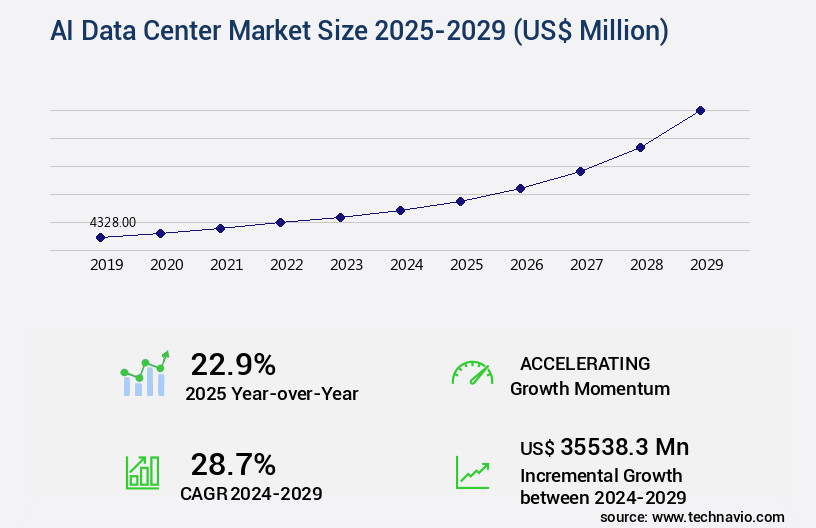
Get Key Insights on Market Forecast (PDF) Request Free Sample
How is the AI Data Center Market Segmented ?
The AI data center industry research report provides comprehensive data (region-wise segment analysis), with forecasts and estimates in "USD million" for the period 2025-2029, as well as historical data from 2019-2023 for the following segments.
- Component
- Hardware
- Software
- Services
- Type
- Hyperscale data centers
- Edge data centers
- Colocation Data centers
- Deployment
- Cloud-based
- On-premises
- Hybrid cloud
- Geography
- North America
- Europe
- France
- Germany
- The Netherlands
- UK
- APAC
- Australia
- China
- India
- Japan
- Rest of World (ROW)
By Component Insights
The hardware segment is estimated to witness significant growth during the forecast period.
The market is undergoing constant evolution, with the hardware segment leading the charge. This segment, comprising the physical infrastructure tailored to AI workloads, is undergoing a significant and capital-intensive transformation. At its core lies the accelerators, specialized processors that execute the parallel mathematical operations necessary for both training and inference. These components, driven by product cycles, are shaping the market's trajectory. For instance, the March 2024 introduction of NVIDIA's Blackwell architecture set a new performance benchmark, necessitating infrastructure upgrades due to its substantial power and cooling requirements. The market also prioritizes power usage effectiveness, with data centers increasingly adopting energy-efficient metrics like GPU acceleration, distributed computing, and server virtualization.
Additionally, there's a growing emphasis on disaster recovery planning, data center automation, and fault tolerance mechanisms. These trends are further influenced by the integration of deep learning frameworks, machine learning algorithms, and AI inference engines into the data center infrastructure. Furthermore, the market is witnessing the emergence of cloud computing platforms, AI ops solutions, and container orchestration, which optimize capacity planning models and network latency. These advancements underscore the dynamic nature of the market, with a projected 35% increase in AI workload optimization by 2026.
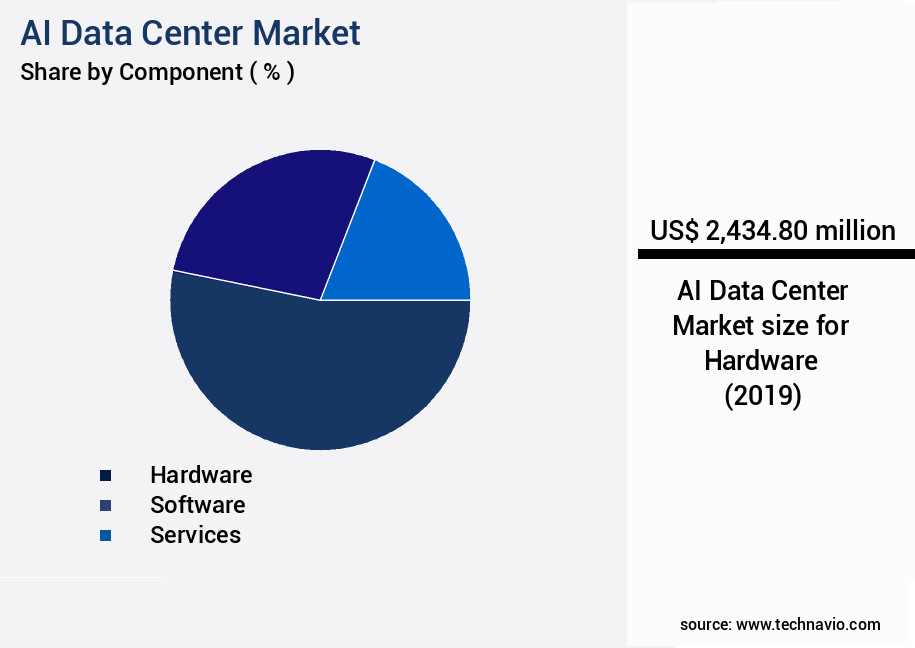
Request Free Sample
The Hardware segment was valued at USD 2.43 billion in 2019 and showed a gradual increase during the forecast period.
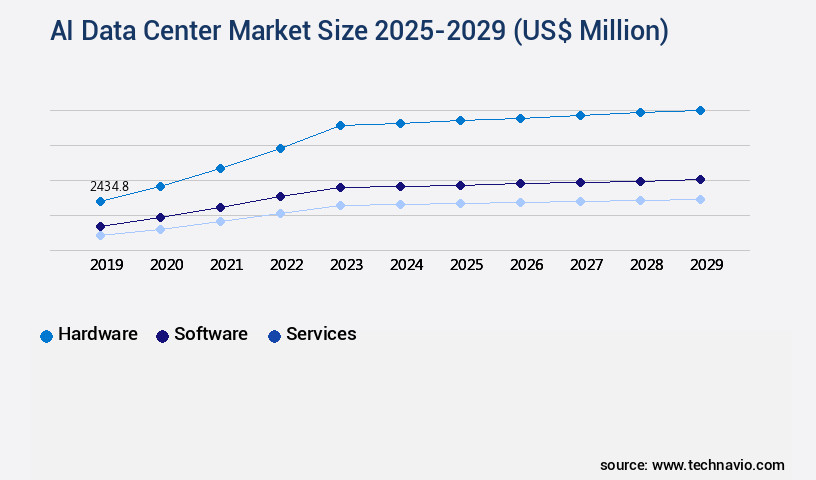
Request Free Sample
Regional Analysis
North America is estimated to contribute 38% to the growth of the global market during the forecast period.Technavio's analysts have elaborately explained the regional trends and drivers that shape the market during the forecast period.
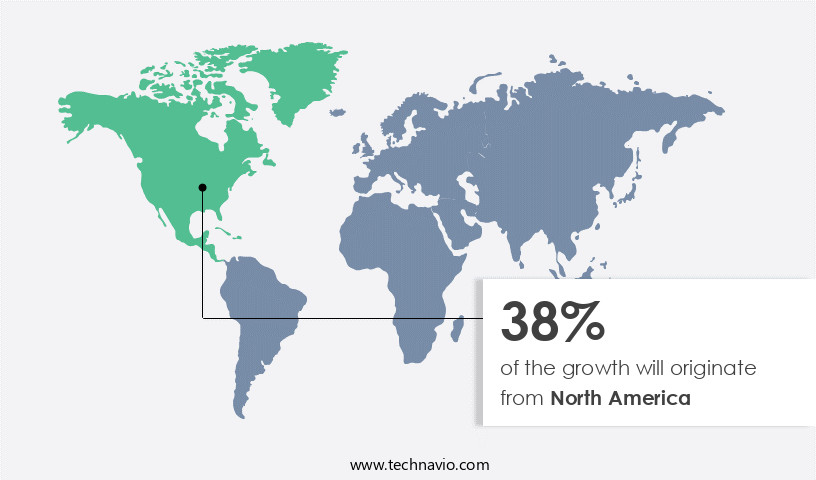
See How AI Data Center Market Demand is Rising in North America Request Free Sample
The market is experiencing significant growth and transformation, with North America leading the charge. This regional dominance is driven by the presence of major hyperscale cloud providers, such as Amazon, Microsoft, and Google, based primarily in the United States. These tech giants are investing heavily in the continuous expansion of their domestic infrastructure to accommodate the burgeoning demand for generative AI services. The market's momentum is fueled by substantial capital expenditures, with hyperscalers investing an estimated USD30 billion annually on data center construction and upgrades. Furthermore, the adoption of AI technologies in data centers is expected to result in operational efficiency gains of up to 30% and cost reductions of up to 45%, making it an essential investment for these companies.
The underlying dynamics of the market are shaped by the collaboration between hardware innovators, like NVIDIA, Intel, and AMD, and hyperscalers, driving technological advancements and the ongoing AI revolution.
Market Dynamics
Our researchers analyzed the data with 2024 as the base year, along with the key drivers, trends, and challenges. A holistic analysis of drivers will help companies refine their marketing strategies to gain a competitive advantage.
The market is experiencing significant growth as businesses seek to optimize AI model performance and efficiently manage GPU server clusters. To achieve this, advanced cooling techniques are being implemented to maintain optimal temperatures and improve data center power usage effectiveness. This is crucial as AI workloads demand high computational power and energy consumption. To deploy resilient AI infrastructure, data centers are scaling workloads across multiple platforms and automating operations. Security is also a top priority, with measures taken to secure AI data center environments and develop fault-tolerant systems. Cloud computing is increasingly being leveraged for AI applications due to its flexibility and scalability. High-performance AI systems are being developed to handle complex workloads, while edge computing is used for real-time AI applications that require low latency.
Monitoring data center performance metrics is essential for predicting and preventing equipment failures, reducing energy consumption, and ensuring the reliability of AI models in production. Managing large-scale AI projects requires careful planning and integration of AI into data center management systems. Optimizing storage for AI applications is another key consideration, as the large amounts of data generated by AI workloads require specialized solutions. Building secure data center networks and deploying AI models in production are also critical components of a successful AI data center strategy. Overall, the market is a dynamic and evolving landscape, requiring a holistic approach to optimize performance, improve efficiency, and ensure security and reliability.
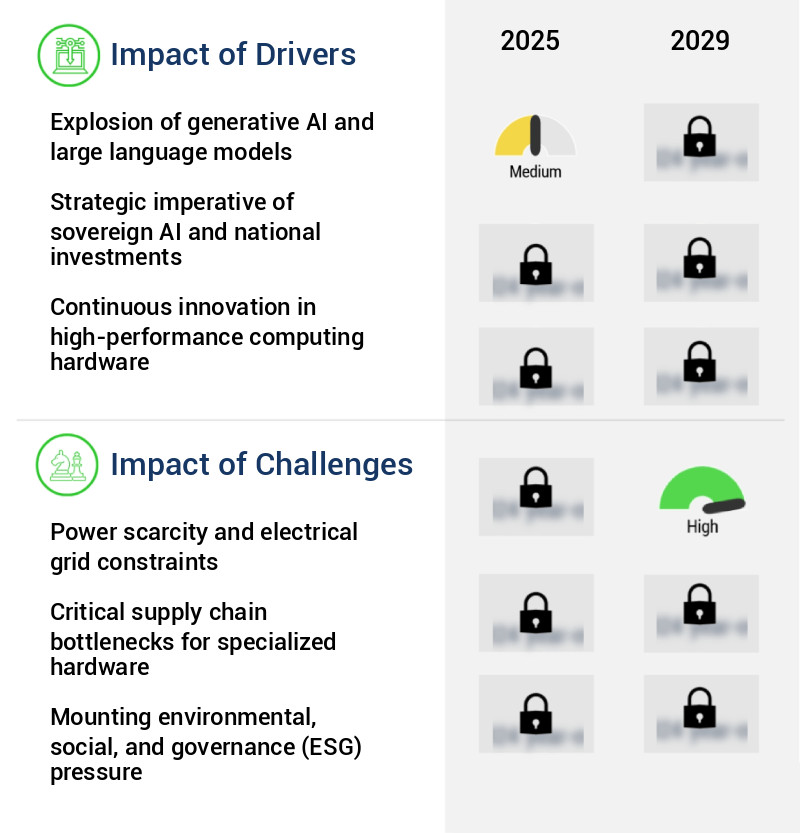
What are the key market drivers leading to the rise in the adoption of AI Data Center Industry?
- The surge in generative AI and large language models is the primary catalyst fueling market growth. These advanced technologies are revolutionizing various industries by generating innovative solutions and enhancing communication capabilities.
- The market is experiencing significant growth due to the increasing adoption of advanced artificial intelligence technologies, particularly generative AI and large language models. These sophisticated models require vast computational resources, leading to a surge in demand for high-performance computing infrastructure. Training such models involves clustering thousands of high-end accelerators, primarily Graphics Processing Units (GPUs), which consume massive amounts of power and generate substantial heat. Traditional data center designs are no longer sufficient, necessitating the development of AI-specific data centers. This shift is driving business outcomes such as increased efficiency, reduced downtime, and enhanced decision-making capabilities. For instance, AI data centers enable organizations to comply with stringent regulatory requirements, such as those related to data privacy and security, by ensuring optimal processing speeds and minimal latency.
- Furthermore, the integration of AI in data centers results in improved forecast accuracy and real-time analytics, leading to more informed business decisions. The evolving nature of the market underscores the importance of investing in future-proof technology solutions to stay competitive in today's data-driven economy.
What are the market trends shaping the AI Data Center Industry?
- Liquid cooling is increasingly becoming a standard requirement in the market trend. The ubiquitous adoption of liquid cooling is shaping the future technology landscape.
- The market is undergoing a significant transformation, with the adoption of liquid cooling becoming a standard for large-scale AI deployments. This shift is driven by the increasing thermal design power of advanced AI accelerators, which outpace the cooling capacity of traditional air-based systems. Modern GPUs and processors can easily surpass 100 kilowatts per rack, whereas air cooling is effective up to around 30 kilowatts per rack.
- This architectural change brings about substantial benefits for businesses, including improved energy efficiency, reduced downtime, and enhanced decision-making capabilities. By employing liquid cooling, data centers can minimize the risk of overheating and ensure optimal performance, ultimately leading to better business outcomes.
What challenges does the AI Data Center Industry face during its growth?
- The industry's growth is significantly impacted by power scarcity and electrical grid constraints, which pose a major challenge.
- The market faces a significant challenge with the increasing energy demands of advanced AI systems. A single high-performance AI accelerator cluster can consume several megawatts, and large-scale AI campuses require power capacities akin to small cities. This energy appetite is putting immense pressure on electrical grids, particularly in major data center hubs. Utility providers are struggling to meet the growing power needs, leading to extended delays in securing electricity for new projects. The power scarcity issue is a pressing concern for businesses aiming to expand their AI capabilities, as it can hinder operational efficiency and growth.
- To mitigate this challenge, companies are exploring alternative energy sources and implementing energy-efficient technologies to reduce their carbon footprint and ensure uninterrupted AI operations.
Exclusive Technavio Analysis on Customer Landscape
The ai data center market forecasting report includes the adoption lifecycle of the market, covering from the innovator's stage to the laggard's stage. It focuses on adoption rates in different regions based on penetration. Furthermore, the ai data center market report also includes key purchase criteria and drivers of price sensitivity to help companies evaluate and develop their market growth analysis strategies.
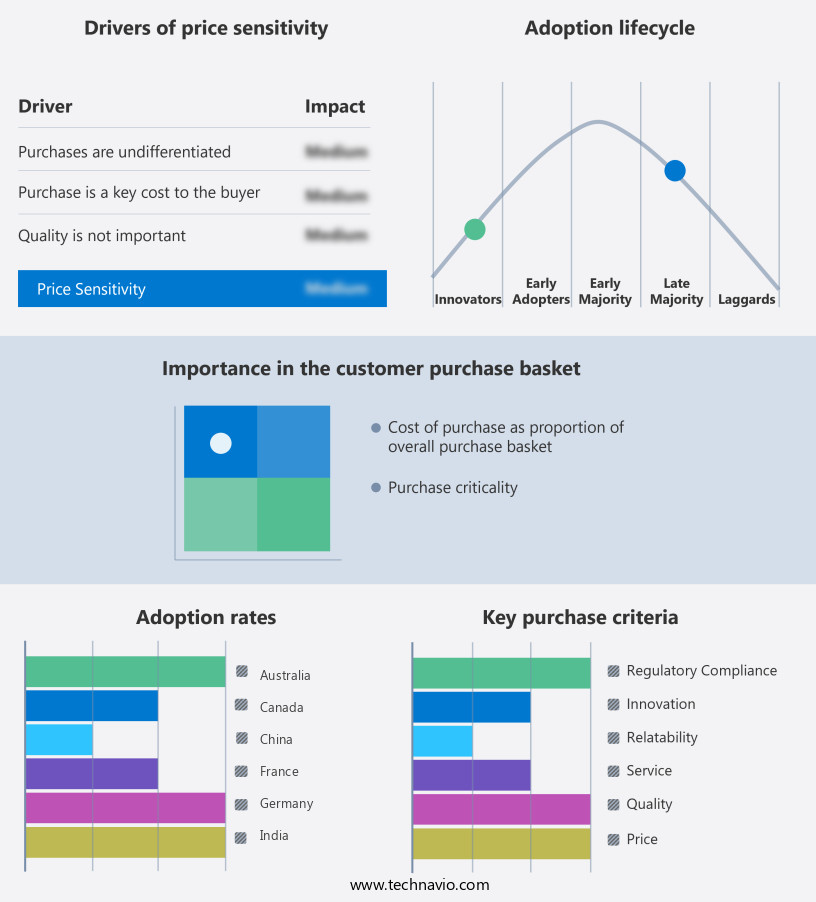
Customer Landscape of AI Data Center Industry
Competitive Landscape
Companies are implementing various strategies, such as strategic alliances, ai data center market forecast, partnerships, mergers and acquisitions, geographical expansion, and product/service launches, to enhance their presence in the industry.
Amazon Web Services Inc. - The company showcases its commitment to advanced AI research with Project Rainier, a vast AI-optimized data center campus in Indiana. Consuming 2.2 gigawatts, this facility accommodates large-scale AI model training using custom silicon, Trainium and Inferentia. This investment underscores the company's dedication to driving technological innovation in the AI sector.
The industry research and growth report includes detailed analyses of the competitive landscape of the market and information about key companies, including:
- Amazon Web Services Inc.
- Dell Technologies Inc.
- Equinix Inc.
- Google LLC
- Hewlett Packard Enterprise Co.
- Intel Corp.
- International Business Machines Corp.
- Juniper Networks Inc.
- Microsoft Corp.
- NVIDIA Corp.
- Oracle Corp.
- Quanta Computer Inc.
- Salesforce Inc.
- Schneider Electric SE
- Snowflake Inc.
- Teradata Corp.
- Toshiba Corp.
Qualitative and quantitative analysis of companies has been conducted to help clients understand the wider business environment as well as the strengths and weaknesses of key industry players. Data is qualitatively analyzed to categorize companies as pure play, category-focused, industry-focused, and diversified; it is quantitatively analyzed to categorize companies as dominant, leading, strong, tentative, and weak.
Recent Development and News in AI Data Center Market
- In August 2024, IBM announced the launch of its new AI-powered data center solution, "IBM Watson for Data Centers," designed to optimize energy consumption and improve operational efficiency. This innovative offering was unveiled at the IBM Think 2024 conference and marks a significant step forward in AI integration within data center infrastructure (IBM Press Release, 2024).
- In November 2024, Amazon Web Services (AWS) and Microsoft Azure entered into a strategic partnership to expand their collaborative efforts in the AI domain. This partnership aimed to provide joint customers with seamless access to both companies' AI services, including AWS's Amazon SageMaker and Microsoft's Azure Machine Learning, enhancing their capabilities in machine learning, deep learning, and AI (AWS Press Release, 2024).
- In March 2025, Google announced a USD1 billion investment in its data centers to support the growing demand for AI and machine learning services. This investment was aimed at expanding Google's data center footprint and improving the performance and reliability of its AI offerings (Google Press Release, 2025).
- In May 2025, NVIDIA and Alibaba Cloud announced a strategic partnership to deliver AI solutions based on NVIDIA's Jetson platform. This collaboration aimed to provide Alibaba Cloud customers with access to NVIDIA's AI technology for edge computing and IoT applications, further expanding Alibaba Cloud's AI offerings (NVIDIA Press Release, 2025).
Dive into Technavio's robust research methodology, blending expert interviews, extensive data synthesis, and validated models for unparalleled AI Data Center Market insights. See full methodology.
|
Market Scope
|
|
Report Coverage
|
Details
|
|
Page number
|
237
|
|
Base year
|
2024
|
|
Historic period
|
2019-2023 |
|
Forecast period
|
2025-2029
|
|
Growth momentum & CAGR
|
Accelerate at a CAGR of 28.7%
|
|
Market growth 2025-2029
|
USD 35538.3 million
|
|
Market structure
|
Fragmented
|
|
YoY growth 2024-2025(%)
|
22.9
|
|
Key countries
|
US, China, Germany, Japan, UK, Canada, India, Australia, France, and The Netherlands
|
|
Competitive landscape
|
Leading Companies, Market Positioning of Companies, Competitive Strategies, and Industry Risks
|
Request Free Sample
Research Analyst Overview
- The market continues to evolve, driven by the increasing adoption of GPU acceleration and deep learning frameworks in various sectors. Data center infrastructure is undergoing significant changes to accommodate the unique requirements of AI workloads, with a focus on power usage effectiveness, fault tolerance mechanisms, and AI inference engines. Disaster recovery planning and data center automation are essential components of modern data centers, ensuring business continuity and optimizing resources. For instance, a leading financial services company reported a 30% increase in sales after implementing machine learning algorithms and distributed computing for fraud detection. Industry growth in AI is expected to reach 25% annually, with data center infrastructure investments playing a crucial role.
- High-performance computing, hyperconverged infrastructure, and thermal management systems are key areas of investment, enabling efficient AI model training and big data processing. Capacity planning models and server virtualization are essential for managing the growing complexity of AI workloads, while energy efficiency metrics and hardware acceleration help reduce costs. AI ops solutions, software-defined networking, and AI inference engines facilitate seamless integration of AI into existing IT infrastructure. Parallel processing systems and container orchestration enable efficient handling of AI workloads, while redundant power systems and network latency optimization ensure reliability and performance. Data center security and cloud computing platforms are critical considerations for organizations embracing AI, with virtual machine management and remote monitoring tools essential for maintaining security and optimizing resources.
- AI inference engines and thermal management systems are also crucial for managing the heat generated by AI workloads, ensuring optimal performance and energy efficiency. In conclusion, the market is a dynamic and evolving landscape, with continuous innovation in areas such as GPU acceleration, deep learning frameworks, and distributed computing driving growth. Organizations must adapt their data center infrastructure to accommodate the unique requirements of AI workloads, focusing on power usage effectiveness, fault tolerance mechanisms, and AI inference engines to optimize resources and ensure business continuity.
What are the Key Data Covered in this AI Data Center Market Research and Growth Report?
-
What is the expected growth of the AI Data Center Market between 2025 and 2029?
-
What segmentation does the market report cover?
-
The report is segmented by Component (Hardware, Software, and Services), Type (Hyperscale data centers, Edge data centers, and Colocation Data centers), Deployment (Cloud-based, On-premises, and Hybrid cloud), and Geography (North America, APAC, Europe, Middle East and Africa, and South America)
-
Which regions are analyzed in the report?
-
North America, APAC, Europe, Middle East and Africa, and South America
-
What are the key growth drivers and market challenges?
-
Who are the major players in the AI Data Center Market?
-
Amazon Web Services Inc., Dell Technologies Inc., Equinix Inc., Google LLC, Hewlett Packard Enterprise Co., Intel Corp., International Business Machines Corp., Juniper Networks Inc., Microsoft Corp., NVIDIA Corp., Oracle Corp., Quanta Computer Inc., Salesforce Inc., Schneider Electric SE, Snowflake Inc., Teradata Corp., and Toshiba Corp.
Market Research Insights
- The market is a continually advancing sector, with increasing demand for advanced computing capabilities. Two significant data points illustrate this trend. First, the adoption of AI model retraining in IT operations management has led to a 30% reduction in error rates, showcasing the value of AI in optimizing business processes. Second, industry experts anticipate a compound growth rate of 25% in the next five years, underpinned by the increasing use of AI in data center design, cybersecurity protocols, and high-frequency trading. For instance, AI workload scaling in public cloud providers enables more efficient resource allocation and infrastructure monitoring, driving demand for AI-powered data center solutions.
- Additionally, the integration of neural network inference and reinforcement learning in Kubernetes clusters and tensorflow optimization in hardware upgrades further fuels market expansion. The market's evolution is characterized by the integration of various technologies, including precision cooling, network virtualization, and uninterruptible power supply, to enhance resilience engineering and PUE reduction strategies. These advancements contribute to the growing importance of AI in data center operations, from virtual desktop infrastructure to data storage solutions and beyond.
We can help! Our analysts can customize this AI data center market research report to meet your requirements.
Get in touch
1 Executive Summary
- 1.1 Market overview
- Executive Summary - Chart on Market Overview
- Executive Summary - Data Table on Market Overview
- Executive Summary - Chart on Global Market Characteristics
- Executive Summary - Chart on Market by Geography
- Executive Summary - Chart on Market Segmentation by Component
- Executive Summary - Chart on Market Segmentation by Type
- Executive Summary - Chart on Market Segmentation by Deployment
- Executive Summary - Chart on Incremental Growth
- Executive Summary - Data Table on Incremental Growth
- Executive Summary - Chart on Company Market Positioning
2 Technavio Analysis
- 2.1 Analysis of price sensitivity, lifecycle, customer purchase basket, adoption rates, and purchase criteria
- Analysis of price sensitivity, lifecycle, customer purchase basket, adoption rates, and purchase criteria
- 2.2 Criticality of inputs and Factors of differentiation
- Overview on criticality of inputs and factors of differentiation
- 2.3 Factors of disruption
- Overview on factors of disruption
- 2.4 Impact of drivers and challenges
- Impact of drivers and challenges in 2024 and 2029
3 Market Landscape
- 3.1 Market ecosystem
- Parent Market
- Data Table on - Parent Market
- 3.2 Market characteristics
- Market characteristics analysis
4 Market Sizing
- 4.1 Market definition
- Offerings of companies included in the market definition
- 4.2 Market segment analysis
- 4.4 Market outlook: Forecast for 2024-2029
- Chart on Global - Market size and forecast 2024-2029 ($ million)
- Data Table on Global - Market size and forecast 2024-2029 ($ million)
- Chart on Global Market: Year-over-year growth 2024-2029 (%)
- Data Table on Global Market: Year-over-year growth 2024-2029 (%)
5 Historic Market Size
- 5.1 Global AI Data Center Market 2019 - 2023
- Historic Market Size - Data Table on Global AI Data Center Market 2019 - 2023 ($ million)
- 5.2 Component segment analysis 2019 - 2023
- Historic Market Size - Component Segment 2019 - 2023 ($ million)
- 5.3 Type segment analysis 2019 - 2023
- Historic Market Size - Type Segment 2019 - 2023 ($ million)
- 5.4 Deployment segment analysis 2019 - 2023
- Historic Market Size - Deployment Segment 2019 - 2023 ($ million)
- 5.5 Geography segment analysis 2019 - 2023
- Historic Market Size - Geography Segment 2019 - 2023 ($ million)
- 5.6 Country segment analysis 2019 - 2023
- Historic Market Size - Country Segment 2019 - 2023 ($ million)
6 Five Forces Analysis
- 6.1 Five forces summary
- Five forces analysis - Comparison between 2024 and 2029
- 6.2 Bargaining power of buyers
- Bargaining power of buyers - Impact of key factors 2024 and 2029
- 6.3 Bargaining power of suppliers
- Bargaining power of suppliers - Impact of key factors in 2024 and 2029
- 6.4 Threat of new entrants
- Threat of new entrants - Impact of key factors in 2024 and 2029
- 6.5 Threat of substitutes
- Threat of substitutes - Impact of key factors in 2024 and 2029
- 6.6 Threat of rivalry
- Threat of rivalry - Impact of key factors in 2024 and 2029
- 6.7 Market condition
- Chart on Market condition - Five forces 2024 and 2029
7 Market Segmentation by Component
- 7.1 Market segments
- Chart on Component - Market share 2024-2029 (%)
- Data Table on Component - Market share 2024-2029 (%)
- 7.2 Comparison by Component
- Chart on Comparison by Component
- Data Table on Comparison by Component
- 7.3 Hardware - Market size and forecast 2024-2029
- Chart on Hardware - Market size and forecast 2024-2029 ($ million)
- Data Table on Hardware - Market size and forecast 2024-2029 ($ million)
- Chart on Hardware - Year-over-year growth 2024-2029 (%)
- Data Table on Hardware - Year-over-year growth 2024-2029 (%)
- 7.4 Software - Market size and forecast 2024-2029
- Chart on Software - Market size and forecast 2024-2029 ($ million)
- Data Table on Software - Market size and forecast 2024-2029 ($ million)
- Chart on Software - Year-over-year growth 2024-2029 (%)
- Data Table on Software - Year-over-year growth 2024-2029 (%)
- 7.5 Services - Market size and forecast 2024-2029
- Chart on Services - Market size and forecast 2024-2029 ($ million)
- Data Table on Services - Market size and forecast 2024-2029 ($ million)
- Chart on Services - Year-over-year growth 2024-2029 (%)
- Data Table on Services - Year-over-year growth 2024-2029 (%)
- 7.6 Market opportunity by Component
- Market opportunity by Component ($ million)
- Data Table on Market opportunity by Component ($ million)
8 Market Segmentation by Type
- 8.1 Market segments
- Chart on Type - Market share 2024-2029 (%)
- Data Table on Type - Market share 2024-2029 (%)
- 8.2 Comparison by Type
- Chart on Comparison by Type
- Data Table on Comparison by Type
- 8.3 Hyperscale data centers - Market size and forecast 2024-2029
- Chart on Hyperscale data centers - Market size and forecast 2024-2029 ($ million)
- Data Table on Hyperscale data centers - Market size and forecast 2024-2029 ($ million)
- Chart on Hyperscale data centers - Year-over-year growth 2024-2029 (%)
- Data Table on Hyperscale data centers - Year-over-year growth 2024-2029 (%)
- 8.4 Edge data centers - Market size and forecast 2024-2029
- Chart on Edge data centers - Market size and forecast 2024-2029 ($ million)
- Data Table on Edge data centers - Market size and forecast 2024-2029 ($ million)
- Chart on Edge data centers - Year-over-year growth 2024-2029 (%)
- Data Table on Edge data centers - Year-over-year growth 2024-2029 (%)
- 8.5 Colocation Data centers - Market size and forecast 2024-2029
- Chart on Colocation Data centers - Market size and forecast 2024-2029 ($ million)
- Data Table on Colocation Data centers - Market size and forecast 2024-2029 ($ million)
- Chart on Colocation Data centers - Year-over-year growth 2024-2029 (%)
- Data Table on Colocation Data centers - Year-over-year growth 2024-2029 (%)
- 8.6 Market opportunity by Type
- Market opportunity by Type ($ million)
- Data Table on Market opportunity by Type ($ million)
9 Market Segmentation by Deployment
- 9.1 Market segments
- Chart on Deployment - Market share 2024-2029 (%)
- Data Table on Deployment - Market share 2024-2029 (%)
- 9.2 Comparison by Deployment
- Chart on Comparison by Deployment
- Data Table on Comparison by Deployment
- 9.3 Cloud-based - Market size and forecast 2024-2029
- Chart on Cloud-based - Market size and forecast 2024-2029 ($ million)
- Data Table on Cloud-based - Market size and forecast 2024-2029 ($ million)
- Chart on Cloud-based - Year-over-year growth 2024-2029 (%)
- Data Table on Cloud-based - Year-over-year growth 2024-2029 (%)
- 9.4 On-premises - Market size and forecast 2024-2029
- Chart on On-premises - Market size and forecast 2024-2029 ($ million)
- Data Table on On-premises - Market size and forecast 2024-2029 ($ million)
- Chart on On-premises - Year-over-year growth 2024-2029 (%)
- Data Table on On-premises - Year-over-year growth 2024-2029 (%)
- 9.5 Hybrid cloud - Market size and forecast 2024-2029
- Chart on Hybrid cloud - Market size and forecast 2024-2029 ($ million)
- Data Table on Hybrid cloud - Market size and forecast 2024-2029 ($ million)
- Chart on Hybrid cloud - Year-over-year growth 2024-2029 (%)
- Data Table on Hybrid cloud - Year-over-year growth 2024-2029 (%)
- 9.6 Market opportunity by Deployment
- Market opportunity by Deployment ($ million)
- Data Table on Market opportunity by Deployment ($ million)
10 Customer Landscape
- 10.1 Customer landscape overview
- Analysis of price sensitivity, lifecycle, customer purchase basket, adoption rates, and purchase criteria
11 Geographic Landscape
- 11.1 Geographic segmentation
- Chart on Market share by geography 2024-2029 (%)
- Data Table on Market share by geography 2024-2029 (%)
- 11.2 Geographic comparison
- Chart on Geographic comparison
- Data Table on Geographic comparison
- 11.3 North America - Market size and forecast 2024-2029
- Chart on North America - Market size and forecast 2024-2029 ($ million)
- Data Table on North America - Market size and forecast 2024-2029 ($ million)
- Chart on North America - Year-over-year growth 2024-2029 (%)
- Data Table on North America - Year-over-year growth 2024-2029 (%)
- 11.4 APAC - Market size and forecast 2024-2029
- Chart on APAC - Market size and forecast 2024-2029 ($ million)
- Data Table on APAC - Market size and forecast 2024-2029 ($ million)
- Chart on APAC - Year-over-year growth 2024-2029 (%)
- Data Table on APAC - Year-over-year growth 2024-2029 (%)
- 11.5 Europe - Market size and forecast 2024-2029
- Chart on Europe - Market size and forecast 2024-2029 ($ million)
- Data Table on Europe - Market size and forecast 2024-2029 ($ million)
- Chart on Europe - Year-over-year growth 2024-2029 (%)
- Data Table on Europe - Year-over-year growth 2024-2029 (%)
- 11.6 Middle East and Africa - Market size and forecast 2024-2029
- Chart on Middle East and Africa - Market size and forecast 2024-2029 ($ million)
- Data Table on Middle East and Africa - Market size and forecast 2024-2029 ($ million)
- Chart on Middle East and Africa - Year-over-year growth 2024-2029 (%)
- Data Table on Middle East and Africa - Year-over-year growth 2024-2029 (%)
- 11.7 South America - Market size and forecast 2024-2029
- Chart on South America - Market size and forecast 2024-2029 ($ million)
- Data Table on South America - Market size and forecast 2024-2029 ($ million)
- Chart on South America - Year-over-year growth 2024-2029 (%)
- Data Table on South America - Year-over-year growth 2024-2029 (%)
- 11.8 US - Market size and forecast 2024-2029
- Chart on US - Market size and forecast 2024-2029 ($ million)
- Data Table on US - Market size and forecast 2024-2029 ($ million)
- Chart on US - Year-over-year growth 2024-2029 (%)
- Data Table on US - Year-over-year growth 2024-2029 (%)
- 11.9 China - Market size and forecast 2024-2029
- Chart on China - Market size and forecast 2024-2029 ($ million)
- Data Table on China - Market size and forecast 2024-2029 ($ million)
- Chart on China - Year-over-year growth 2024-2029 (%)
- Data Table on China - Year-over-year growth 2024-2029 (%)
- 11.10 Canada - Market size and forecast 2024-2029
- Chart on Canada - Market size and forecast 2024-2029 ($ million)
- Data Table on Canada - Market size and forecast 2024-2029 ($ million)
- Chart on Canada - Year-over-year growth 2024-2029 (%)
- Data Table on Canada - Year-over-year growth 2024-2029 (%)
- 11.11 Japan - Market size and forecast 2024-2029
- Chart on Japan - Market size and forecast 2024-2029 ($ million)
- Data Table on Japan - Market size and forecast 2024-2029 ($ million)
- Chart on Japan - Year-over-year growth 2024-2029 (%)
- Data Table on Japan - Year-over-year growth 2024-2029 (%)
- 11.12 India - Market size and forecast 2024-2029
- Chart on India - Market size and forecast 2024-2029 ($ million)
- Data Table on India - Market size and forecast 2024-2029 ($ million)
- Chart on India - Year-over-year growth 2024-2029 (%)
- Data Table on India - Year-over-year growth 2024-2029 (%)
- 11.13 Germany - Market size and forecast 2024-2029
- Chart on Germany - Market size and forecast 2024-2029 ($ million)
- Data Table on Germany - Market size and forecast 2024-2029 ($ million)
- Chart on Germany - Year-over-year growth 2024-2029 (%)
- Data Table on Germany - Year-over-year growth 2024-2029 (%)
- 11.14 UK - Market size and forecast 2024-2029
- Chart on UK - Market size and forecast 2024-2029 ($ million)
- Data Table on UK - Market size and forecast 2024-2029 ($ million)
- Chart on UK - Year-over-year growth 2024-2029 (%)
- Data Table on UK - Year-over-year growth 2024-2029 (%)
- 11.15 Australia - Market size and forecast 2024-2029
- Chart on Australia - Market size and forecast 2024-2029 ($ million)
- Data Table on Australia - Market size and forecast 2024-2029 ($ million)
- Chart on Australia - Year-over-year growth 2024-2029 (%)
- Data Table on Australia - Year-over-year growth 2024-2029 (%)
- 11.16 France - Market size and forecast 2024-2029
- Chart on France - Market size and forecast 2024-2029 ($ million)
- Data Table on France - Market size and forecast 2024-2029 ($ million)
- Chart on France - Year-over-year growth 2024-2029 (%)
- Data Table on France - Year-over-year growth 2024-2029 (%)
- 11.17 The Netherlands - Market size and forecast 2024-2029
- Chart on The Netherlands - Market size and forecast 2024-2029 ($ million)
- Data Table on The Netherlands - Market size and forecast 2024-2029 ($ million)
- Chart on The Netherlands - Year-over-year growth 2024-2029 (%)
- Data Table on The Netherlands - Year-over-year growth 2024-2029 (%)
- 11.18 Market opportunity by geography
- Market opportunity by geography ($ million)
- Data Tables on Market opportunity by geography ($ million)
12 Drivers, Challenges, and Opportunity/Restraints
- 12.3 Impact of drivers and challenges
- Impact of drivers and challenges in 2024 and 2029
- 12.4 Market opportunities/restraints
13 Competitive Landscape
- 13.2 Competitive Landscape
- Overview on criticality of inputs and factors of differentiation
- 13.3 Landscape disruption
- Overview on factors of disruption
- 13.4 Industry risks
- Impact of key risks on business
14 Competitive Analysis
- 14.2 Company ranking index
- 14.3 Market positioning of companies
- Matrix on companies position and classification
- 14.4 Amazon Web Services Inc.
- Amazon Web Services Inc. - Overview
- Amazon Web Services Inc. - Product / Service
- Amazon Web Services Inc. - Key news
- Amazon Web Services Inc. - Key offerings
- SWOT
- 14.5 Dell Technologies Inc.
- Dell Technologies Inc. - Overview
- Dell Technologies Inc. - Business segments
- Dell Technologies Inc. - Key news
- Dell Technologies Inc. - Key offerings
- Dell Technologies Inc. - Segment focus
- SWOT
- 14.6 Equinix Inc.
- Equinix Inc. - Overview
- Equinix Inc. - Business segments
- Equinix Inc. - Key news
- Equinix Inc. - Key offerings
- Equinix Inc. - Segment focus
- SWOT
- 14.7 Google LLC
- Google LLC - Overview
- Google LLC - Product / Service
- Google LLC - Key news
- Google LLC - Key offerings
- SWOT
- 14.8 Hewlett Packard Enterprise Co.
- Hewlett Packard Enterprise Co. - Overview
- Hewlett Packard Enterprise Co. - Business segments
- Hewlett Packard Enterprise Co. - Key news
- Hewlett Packard Enterprise Co. - Key offerings
- Hewlett Packard Enterprise Co. - Segment focus
- SWOT
- 14.9 Intel Corp.
- Intel Corp. - Overview
- Intel Corp. - Business segments
- Intel Corp. - Key news
- Intel Corp. - Key offerings
- Intel Corp. - Segment focus
- SWOT
- 14.10 International Business Machines Corp.
- International Business Machines Corp. - Overview
- International Business Machines Corp. - Business segments
- International Business Machines Corp. - Key news
- International Business Machines Corp. - Key offerings
- International Business Machines Corp. - Segment focus
- SWOT
- 14.11 Juniper Networks Inc.
- Juniper Networks Inc. - Overview
- Juniper Networks Inc. - Product / Service
- Juniper Networks Inc. - Key news
- Juniper Networks Inc. - Key offerings
- SWOT
- 14.12 Microsoft Corp.
- Microsoft Corp. - Overview
- Microsoft Corp. - Business segments
- Microsoft Corp. - Key news
- Microsoft Corp. - Key offerings
- Microsoft Corp. - Segment focus
- SWOT
- 14.13 NVIDIA Corp.
- NVIDIA Corp. - Overview
- NVIDIA Corp. - Business segments
- NVIDIA Corp. - Key news
- NVIDIA Corp. - Key offerings
- NVIDIA Corp. - Segment focus
- SWOT
- 14.14 Oracle Corp.
- Oracle Corp. - Overview
- Oracle Corp. - Business segments
- Oracle Corp. - Key news
- Oracle Corp. - Key offerings
- Oracle Corp. - Segment focus
- SWOT
- 14.15 Salesforce Inc.
- Salesforce Inc. - Overview
- Salesforce Inc. - Product / Service
- Salesforce Inc. - Key news
- Salesforce Inc. - Key offerings
- SWOT
- 14.16 Schneider Electric SE
- Schneider Electric SE - Overview
- Schneider Electric SE - Business segments
- Schneider Electric SE - Key news
- Schneider Electric SE - Key offerings
- Schneider Electric SE - Segment focus
- SWOT
- 14.17 Snowflake Inc.
- Snowflake Inc. - Overview
- Snowflake Inc. - Product / Service
- Snowflake Inc. - Key news
- Snowflake Inc. - Key offerings
- SWOT
- 14.18 Teradata Corp.
- Teradata Corp. - Overview
- Teradata Corp. - Business segments
- Teradata Corp. - Key news
- Teradata Corp. - Key offerings
- Teradata Corp. - Segment focus
- SWOT
15 Appendix
- 15.2 Inclusions and exclusions checklist
- Inclusions checklist
- Exclusions checklist
- 15.3 Currency conversion rates for US$
- Currency conversion rates for US$
- 15.4 Research methodology
- 15.7 Validation techniques employed for market sizing
- Validation techniques employed for market sizing
- 15.9 360 degree market analysis
- 360 degree market analysis
- 15.10 List of abbreviations







![]() Get the report (PDF) sent to your email within minutes.
Get the report (PDF) sent to your email within minutes.
Complimentary full Excel data with your report purchase.